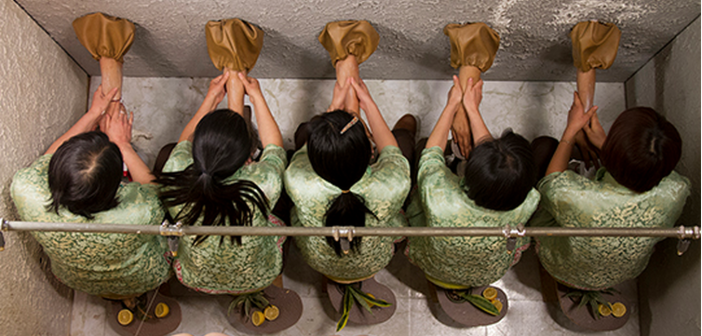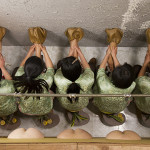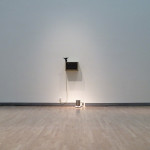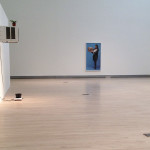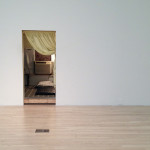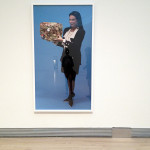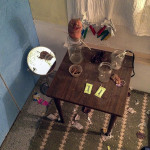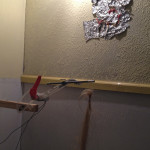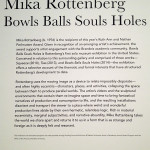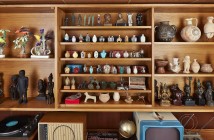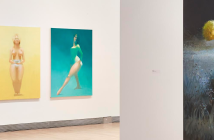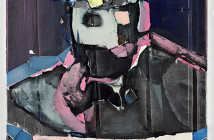Boston-based film and video artists Tara Merenda Nelson and Lana Z. Caplan met at The Rose Art Museum to explore the current exhibit by Argentinian-born artist Mika Rottenberg, "Bowls Balls Souls Holes". Rottenberg conceived and designed her exhibition specifically for the Rose Museum, and chose three works — Squeeze (2010), Tsss (2013), and Bowls Balls Souls Holes (2014) — to address formal and conceptual issues of consumption, production, labor and the layers that compose (and collapse upon) the world around us. Each of the three works in the exhibit are multi-media, using video, sculpture, photography and installation to relay Rottenberg’s unique vision of the structures of human experience.
After visiting the show, Tara and Lana met for coffee, and talked about their own experiences with the show:
TN What did you think?
LC I loved it. I really loved the way she uses installation and space and forces the viewer to be aware of the space around them. Having to climb through the wall of a room in order to continue to experience the piece was especially interesting. I was also interested in how the video viewing space itself was set up. There was a platform in front of the screen, which made me consider the elevation of the ‘art object’ and how that relates to production, which is explored in the context of the video.
TN Do you think that was her choice, or the choice of the Gallery?
LC I don’t know, but it seemed very intentional.
TN My first reaction upon entering the show was "Oh no, Art School is back"
LC The dirty ashtray….
TN I hadn’t even gotten that deep into the show, this was my reaction upon entering the gallery. I saw the vastly empty white room with a very old air conditioning unit on the wall, dripping into a thrift store saucepan on a hotplate. It was overwhelmingly formal, referencing domestic space in the context of the gallery… that sort of thing. That was a ‘deep sigh’ moment for me. Yet at the same time there is something very inviting and friendly about the first glimpse of the show. A lot of that has to do with the Rose, which is such a comfortable gallery, so soft and familiar, like being in someone’s home. So, while some of the pieces felt formal, I was also drawn in by the inviting space, the openness of it, and the light. It actually took me a while to discover the individual parts that made up the whole of the installation. Isn’t that odd, how fewer pieces can take sometimes take longer to notice?
LC I love that kind of discovery.
TN I think I had been around the whole gallery once before I noticed the room behind the curtain. It was like finding a mouse hole. But after entering that room I had another deep-sigh moment. Trash on the floor, dropped ceilings, stale air, another air conditioner…
LC The dirty ashtray.
TN There was really a tremendous amount of … stuff … in that tiny space. I was taking notes so I started to write down everything I saw, and the process of list-making led to another revealing moment. It was like an archeological dig, like I had crawled into the catacombs to copy the hieroglyphs on the wall. There was an observable code to decipher, and it began to make sense, to feel significant. And being in that tiny room alone was so visceral — it felt dry and dirty, with that tiny fountain of foul gray water running in the corner, kneeling on the filthy carpet, crouching under the dropped ceiling tiles. I was in there for maybe ten minutes before I noticed there was a window covered with a dishcloth, and on the other side there was a big empty room with a movie playing! That was when one of the curators crawled in behind me and pushed the wall…
LC And it opened to another room.
TN …and I was thrilled. It felt so good to crawl into another space after being in that room; it was such a relief.
LC I was in that gallery for a talk on another artist last month, and afterwards I explored the show. While I was in that room someone came in and showed me that the wall opened. I don’t if it would have been a totally different experience for me had I discovered that on my own — or missed it entirely.
TN I love it when I discover I am wrong about an experience while the experience is still happening. While I was crouching in that room making lists, I was ready to shut-down towards the entire show. I was reading everything formally and listing all of the parts without reading the entire equation. Only after having the full experience — finding the room, watching the video — was I able to see it as a whole. And now I feel much differently.
LC How so?
TN I think this show is more than the sum of its parts.
LC The video really ties it all together for me.
TN Rottenberg made great use of the 20-minute loop in her videos. She showed me something that took 20 minutes to see. The whole equation was there.
LC It unfolds over that entire amount of time, piece by piece. Like little clues to the greater mystery…
TN It de-codes. I think she is very generous in what she reveals in the video. Every single thing I listed in that small room came back in the video, and I understood both the origin and the destination of the object. And yet the objects are still weird — they stay complicated and problematic, but I feel satisfied with the reference, and I stay interested. She is extraordinarily intentional about how her objects relate to the human experience. And she lets it all be deciphered. But it takes time.
LC I think every bit is excessively considered, and in some part alienating. Because the casual viewer is not going to sit for 20 minutes to let it unfold, and they will be completely confused. They are going to walk out feeling stupid.
TN If they aren’t willing to give it half an hour, they deserve to feel stupid. But I think there is plenty there for the casual observer. The air conditioners drip into the saucepan, the water evaporates and the plant absorbs it - that’s easy. The wall opens into a small theater. That’s easy too.
LC True - there is a sense of discovery, you get that right away. When I visited the first time, the gallery was closing so I wasn’t able to see everything, but I was excited by the idea that there was more going on than what was immediately apparent. I was excited to come back.
TN How was it to come back and see everything again?
LC Well, like you said — the sum of the parts was more interesting than the parts themselves. For instance, the photo of her dealer, Mary Boone, holding a cube of garbage was much more intriguing to me after I watched the video about the production of that cube as an art object. And understanding that she shipped that cube to be held in perpetuity in cold storage in the Cayman Islands, where people store their money in off-shore accounts…all of that made the photo itself have meaning. At first glance, Mary Boone looked an airline stewardess holding a cube of garbage. I was thrilled to uncover many more layers and irony through the video and the shipping receipt on the wall. I think it is often hard to exhibit conceptual work in the gallery and make it visually engaging and I am not sure this installation was seductive for me visually. Taped up on the wall, the shipping receipt looked like a paper left up from the installation, a place-holder, or a label a museum would put up temporarily when a work is on loan. But, given the sparse number of objects in the room, I took the time and interest to read the paper, where if there were many more things to explore, I may have skipped it and missed the final destination of the carefully produced and documented object. Though, conceptually I liked how it all functioned and by taping the receipt on the wall, as opposed to framing or something else, it does make a distinction between what is the art object and what is not, at least in the exhibition.
TN The elements of that particular piece, Squeeze, are good examples of Rottenberg’s intentional, inter-dimensional layering. She takes us from a two-dimensional photo portraying an object into another room, another space, where a video (a time-based layer) reveals the process of creating the object represented in the photo.
LC There is an interconnected-ness to everything in this show.
TN She reveals not only the process of building the cube, but also the process of creating the objects that create the cube…
LC Latex, Lettuce and Blush.
TN Why those three elements? Why three elements and not four? How do three things make a cube? Why a cube? …. I am sure she has reasons for connecting all of these things. And her connections are so circular, which is satisfying.
LC I love the reference, association and connection to the Body in her work. Like (in Squeeze) the tongues and butts sticking out of the wall and the idea of latex being a skin, and "heads" of lettuce…all of these references to the use of the body, and our embodiment of these ideas and how we relate to them physically. It creates a sense of culpability between the viewer and the work. It brings a human aspect to it.
TN I was thinking about the personal/impersonal experience I had with the show. Rottenberg’s videos depict women almost exclusively, but they are not characters as much as they are mannequins. They don’t speak or have gestures or expressions. They play a role inside an authored world of circular metaphors. Then I thought about how I was playing a role when my body was inside that tiny room, that authored space that Rottenberg had created. I had a personal experience with the room, and I could reference that experience when I watched the video. A woman was lying on the same dirty floor I had just been kneeling on, and I could feel it. She didn’t have to move or do anything to make me feel the room, and understand her experience. Otherwise I didn’t connect with the women in the video on a personal level. I saw them as representations — of labor, of the body — playing that type of role. Still interesting, but not always familiar.
LC I think she did that with the use of the body, the tongue sticking through the wall…
TN But there is no body, the tongue is disembodied, its just a tongue. It doesn’t belong to anyone.
LC And yet you still identified with it and have a visceral reaction when it is sprayed with water. I can see how Rottenberg creates a distance from her characters as people in order create another mental-space for what is going on. Through disengaging, you become engaged on a different level, a metaphoric level. It might not be personal, but it is allegorical.
Mika Rottenberg: Bowls Balls Souls Holes is on display until Sunday June 8th. The Rose Art Museum, Brandeis University
- Mika Rottenberg, Still from Squeeze, 2010, Single Channel Video Installation and Digital C-Print, 20 Min. Courtesy the Artist and Andrea Rosen Gallery, New York, New York
- Photo: Tara Merenda Nelson
- Photo: Tara Merenda Nelson
- Photo: Tara Merenda Nelson
- Photo: Tara Merenda Nelson
- Photo: Tara Merenda Nelson
- Photo: Tara Merenda Nelson

